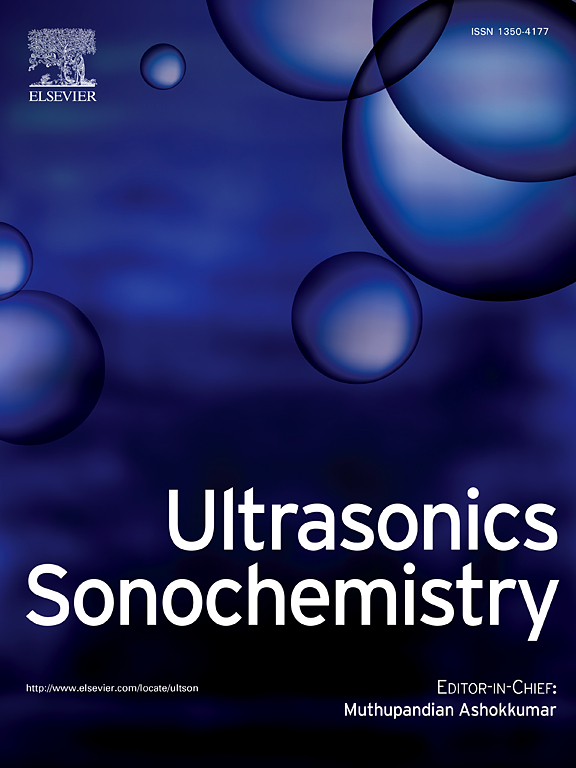双频超声辅助酶解合成用于高性能超级电容器的微结构调控生物质衍生多孔碳。
IF 8.7
1区 化学
Q1 ACOUSTICS
引用次数: 0
摘要
生物质衍生多孔碳(PC)是一种很有前途的储能电极材料,对其前驱体进行有效预处理是提高其电化学性能的关键策略。然而,通过环境友好、简单和有效的方法实现这一目标仍然存在挑战。本文提出了双频超声辅助酶解结合碳化活化法制备高性能超级电容器用大蒜皮衍生PC (DUGPC)的方法。温和而有效的声生物催化有助于前体的微观结构调节和成分管理,赋予DUGPC令人印象深刻的比表面积(SSA, 3006 m2/g),改善的孔隙分布,低金属杂质含量(小于100 ppm)和高润湿性。正如预期的那样,DUGPC表现出优异的比电容(在1 A/g时为408.77 F/g)和速率性能(在50 A/g时保留率为81.8%),超过了最近报道的基于生物质的pc。此外,组装的水对称超级电容器在50.04 W kg-1功率密度下获得了15.78 Wh kg-1的优异能量密度,在5 a /g下循环10000次后的循环稳定性达到了95.5%,组装的2.8 V高压有机超级电容器在139.86 W kg-1功率密度下获得了58.96 Wh kg-1的超高能量密度。值得注意的是,这种双频超声辅助酶解策略有望适用于各种生物质废弃物,促进生物质在储能领域的高价值利用。本文章由计算机程序翻译,如有差异,请以英文原文为准。

Dual-frequency ultrasonic-assisted enzymolysis for synthesis of microstructure regulated biomass-derived porous carbon for high-performance supercapacitors
Biomass-derived porous carbon (PC) has emerged as a promising candidate for electrode materials in energy storage applications, effective pretreatment of the precursor is a key strategy for enhancing the electrochemical performance of PC. However, challenges remain in achieving this goal through environmentally friendly, simple, and efficient methods. In this paper, a dual-frequency ultrasonic-assisted enzymolysis strategy combined with carbonization-activation method was proposed to prepare high-performance garlic peel-derived PC (DUGPC) for supercapacitors. Gentle and effective sonobiocatalysis facilitates microstructural regulation and composition management of the precursor, granting DUGPC an impressive specific surface area (SSA, 3006 m2/g), improved pore distribution, low metal impurity content (less than 100 ppm) and high wettability. As anticipated, DUGPC demonstrates excellent specific capacitance (408.77 F/g at 1 A/g) and rate performance (retention is 81.8 % at 50 A/g) surpassing most recently reported biomass-based PCs. In addition, the assembled aqueous symmetric supercapacitor achieves an excellent energy density of 15.78 Wh kg−1 at a power density of 50.04 W kg−1 with a remarkable cycle stability of 95.5 % after 10,000 cycles at 5 A/g, and the assembled 2.8 V high-voltage organic supercapacitor even exhibits an ultra-high energy density of 58.96 Wh kg−1 at a power density of 139.86 W kg−1. Significantly, this dual-frequency ultrasonic-assisted enzymolysis strategy is expected to be applicable to various biomass wastes and promotes the high-value utilization of biomass in the field of energy storage.
求助全文
通过发布文献求助,成功后即可免费获取论文全文。
去求助
来源期刊

Ultrasonics Sonochemistry
化学-化学综合
CiteScore
15.80
自引率
11.90%
发文量
361
审稿时长
59 days
期刊介绍:
Ultrasonics Sonochemistry stands as a premier international journal dedicated to the publication of high-quality research articles primarily focusing on chemical reactions and reactors induced by ultrasonic waves, known as sonochemistry. Beyond chemical reactions, the journal also welcomes contributions related to cavitation-induced events and processing, including sonoluminescence, and the transformation of materials on chemical, physical, and biological levels.
Since its inception in 1994, Ultrasonics Sonochemistry has consistently maintained a top ranking in the "Acoustics" category, reflecting its esteemed reputation in the field. The journal publishes exceptional papers covering various areas of ultrasonics and sonochemistry. Its contributions are highly regarded by both academia and industry stakeholders, demonstrating its relevance and impact in advancing research and innovation.
 求助内容:
求助内容: 应助结果提醒方式:
应助结果提醒方式:


